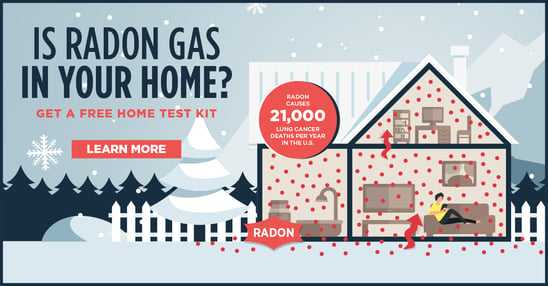Happy New Year from the Climate Action Collaborative (CAC)! January is an exciting time to reflect on the past year (as we did in November and December’s CAC columns) and set goals for what’s to come in 2023. However, there’s another important happening in January that we feel compelled to raise awareness about: Radon Action Month.
Well, what is radon, you may be asking? According to the International Atomic Energy Agency, radon is a source of naturally occurring, dangerous radioactive gas with no color, smell, or taste.
It’s typically released from bedrock rich in uranium and radium, and passes through the soil, where it releases in diluted amounts outdoors. The Environmental Protection Agency (EPA) informs us that when released outdoors, radon disperses rapidly and is usually not a health issue. But when radon is released through the foundation of homes, schools, workplaces, and other building structures, it can become trapped, posing significant health concerns.
Not all radiation is dangerous to humans; non-ionizing waves used for car radios and kitchen microwaves rely on radiation to pass sound or heat foods and liquids. So, why is radon harmful, and what happens when it gets trapped indoors? Radon is an ionizing wave, classified by the World Health Organization and EPA as a carcinogen. When released, radon particulate matter can get trapped inside of structures, accumulating and causing dangerous levels of exposure. This accumulated indoor exposure is what makes radon the second-leading cause of lung cancer after smoking, responsible for roughly 21,000 lung cancer deaths each year in the United States.
The risk of indoor radon accumulation has been, like most things, exacerbated by climate change. As climate change warms the Arctic at rates nearly four times faster than the rest of the globe, it intensifies permafrost thaw, releasing otherwise frozen contaminants, microbes, and molecules, including radioactive radon. Permafrost is ground beneath the Earth’s surface that has been continuously frozen for at least two years, but in most cases, hundreds or thousands of years. The risk of radon release due to climate change-induced permafrost thaw is yet another reason to up the ante on climate action, and a great example of how our actions here in Eagle County reverberate across the globe.
To orient us back home, it’s important we acknowledge the environmental justice association to radon and resources available, as our community is not immune to environmental inequities. Radon mitigation involves testing for radon, sealing for any cracks or holes in the at-risk foundation, and installing a radon mitigation system. However, lower income families and communities are often unable to access the resources needed to install radon mitigation if they have high levels in their home. To aid this challenge, Walking Mountains, in partnership with Vail Health and Eagle County Environmental Health, is offering free radon test kits year-round at several locations throughout the County, including at Shaw Cancer Center for the month of January. Additionally, Walking Mountains Energy Programs can help guide you through the process of testing for radon, finding a contractor for radon mitigation installation, and applying for rebates, which can be secured by completing a Home Energy Assessment. Further financial assistance may be available through the Colorado Department of Public Health and Environment (CDPHE) radon reduction program.
As we kick off our year, let’s prioritize our health and longevity, and make climate action a focal point to reduce further risk of radon exposure in our community and across the globe.

Gina McCrackin is the Climate Action Collaborative Manager at Walking Mountains Science Center. The Climate Action Collaborative is working to reduce greenhouse gas emissions in Eagle County 50% by 2030 and 80% by 2050.






